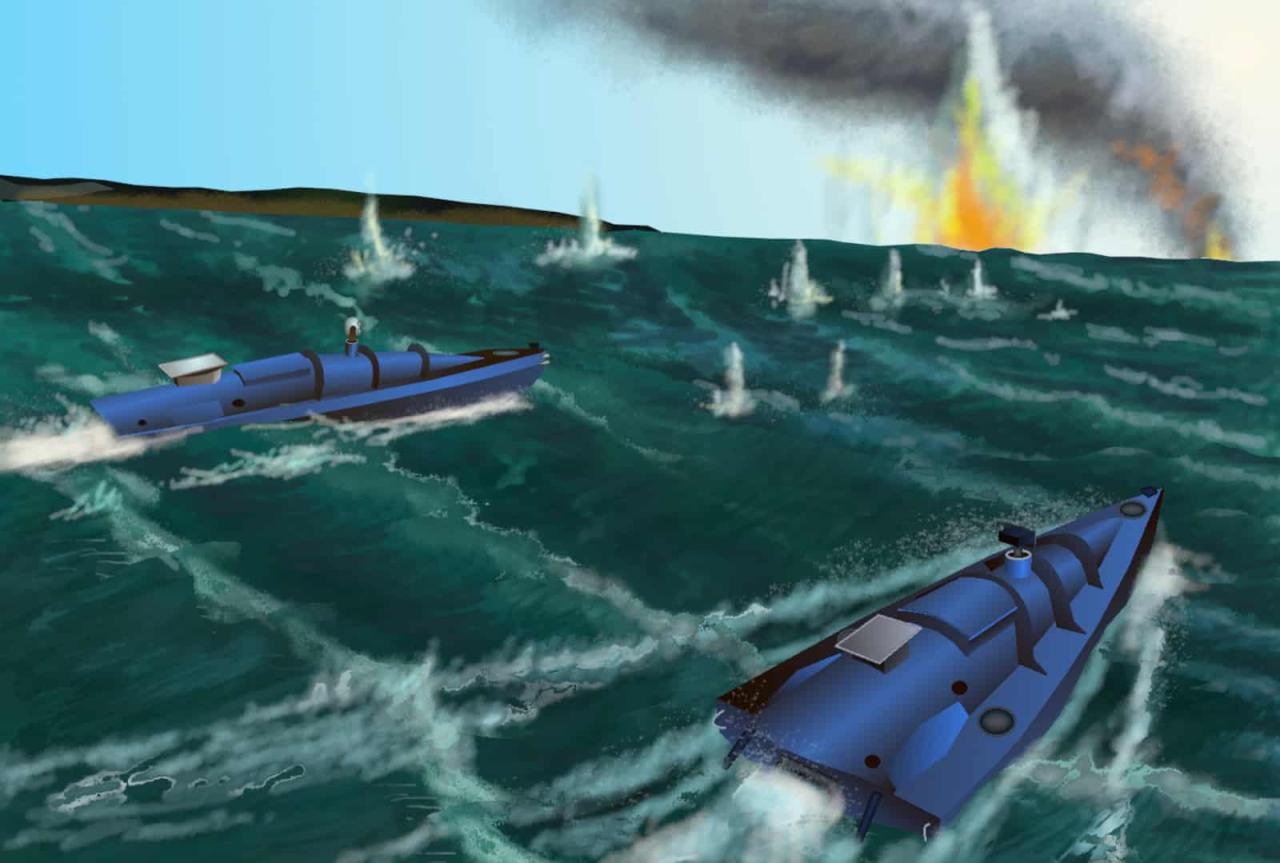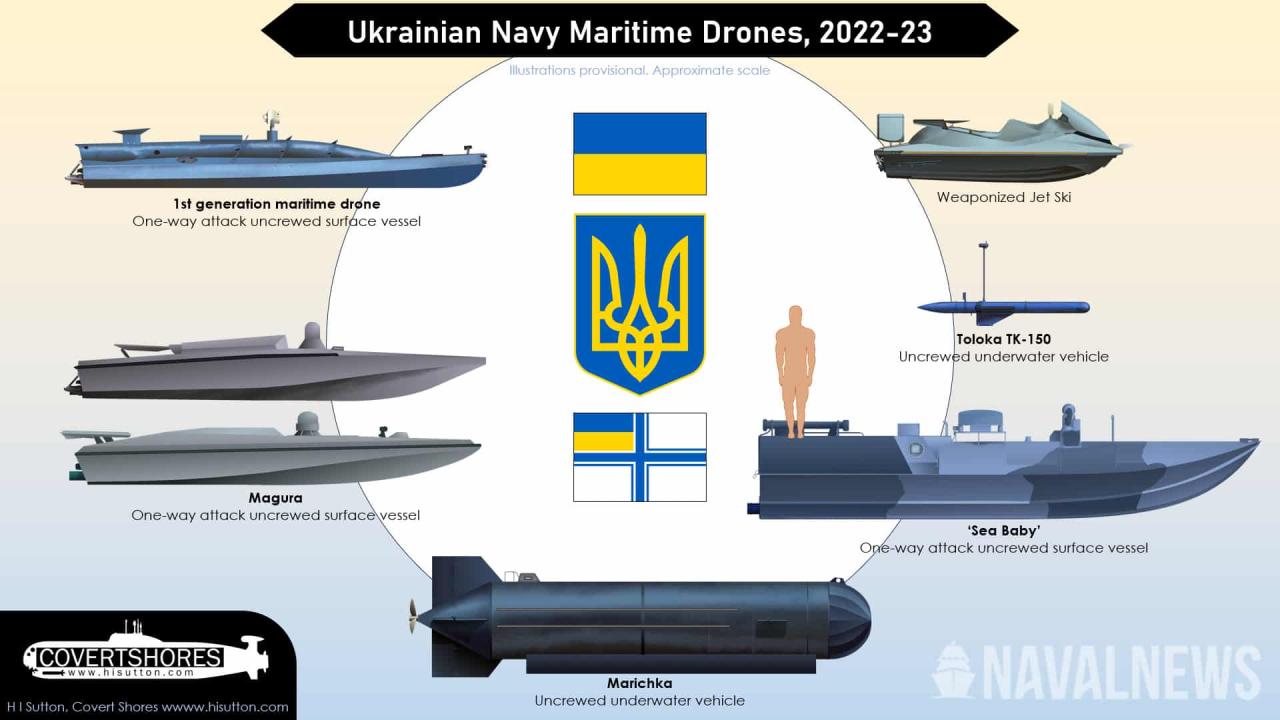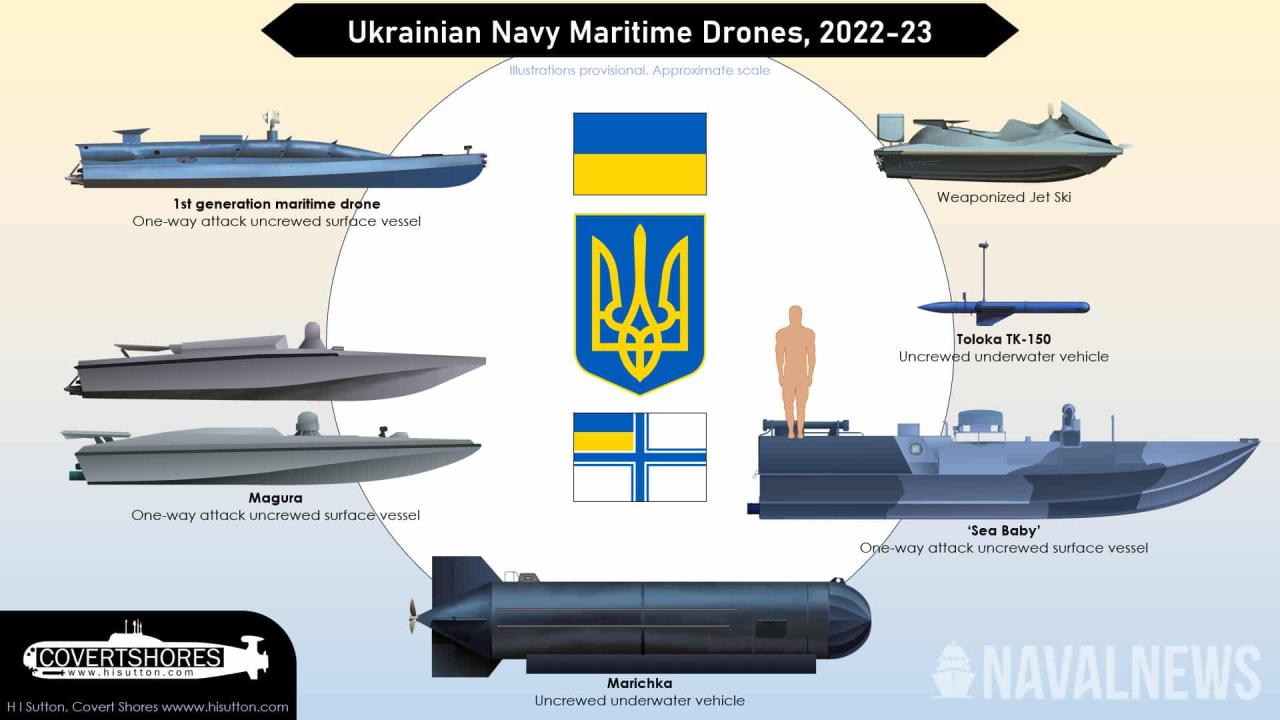Ukrainian sea drones are rapidly changing naval warfare. These unmanned vessels, ranging from small, expendable craft to larger, more sophisticated platforms, are proving surprisingly effective. This exploration delves into their technology, deployment strategies, impact, and the countermeasures being developed to combat them.
From their innovative designs and surprising effectiveness in combat to the implications for future naval strategies, Ukrainian sea drones represent a significant shift in maritime power dynamics. We’ll examine their capabilities, limitations, and the ongoing technological arms race they’ve ignited.
Ukrainian Sea Drones: A Technological Deep Dive
Ukraine’s innovative use of sea drones in the ongoing conflict has significantly impacted naval warfare strategies. This article delves into the technological aspects, operational capabilities, impact, design, and countermeasures related to these unmanned maritime systems.
Types and Functionalities of Ukrainian Sea Drones
Ukraine employs a variety of sea drones, each designed for specific tasks. These range from smaller, expendable drones used for reconnaissance and attacks to larger, more sophisticated systems capable of carrying heavier payloads and operating over longer distances. Functionality varies depending on the drone’s design and payload, encompassing tasks such as reconnaissance, mine-laying, anti-ship attacks, and electronic warfare.
Propulsion Systems
The propulsion systems used in Ukrainian sea drones are varied, reflecting the diverse operational requirements. Smaller drones may utilize electric motors for quieter operation, while larger drones may incorporate more powerful internal combustion engines or water jets for increased speed and range. The choice of propulsion system is a critical design consideration, balancing speed, range, noise signature, and payload capacity.
Communication and Control Systems
Maintaining reliable communication and control is crucial for effective drone operation. Ukrainian sea drones likely utilize a combination of satellite, radio frequency, and potentially even underwater acoustic communication links, depending on the range and operational environment. Control systems could involve pre-programmed missions or real-time operator control via secure communication channels.
Payload Capacity and Range Comparison
Different Ukrainian sea drone models exhibit a wide range in payload capacity and operational range. Larger drones can carry heavier payloads, such as explosives or electronic warfare equipment, over longer distances, while smaller drones are designed for shorter-range missions with lighter payloads. This variability allows for mission tailoring based on specific needs.
| Drone Model (Hypothetical) | Speed (knots) | Range (nautical miles) | Payload (kg) | Size (meters) |
|---|---|---|---|---|
| Model A | 15 | 50 | 50 | 2x1x1 |
| Model B | 25 | 100 | 150 | 3×1.5×1.5 |
| Model C | 10 | 20 | 20 | 1×0.5×0.5 |
Operational Capabilities and Deployment of Ukrainian Sea Drones

The strategic and tactical employment of Ukrainian sea drones has evolved throughout the conflict. Understanding their deployment patterns, advantages, disadvantages, and challenges is crucial for assessing their overall effectiveness.
Ukrainian sea drones are proving to be surprisingly effective, showcasing the potential of smaller, autonomous naval vessels. It’s a far cry from the dazzling spectacle of a coordinated drone display, like the one you can check out at the chinese new year drone show , but both highlight the rapid advancements in drone technology. The precision and coordination needed for either application are impressive, and we’re likely to see even more innovative uses of drones in the future, both on land and at sea.
Timeline of Significant Deployments
While precise details regarding specific deployments are often kept confidential for security reasons, reports indicate the use of Ukrainian sea drones has increased significantly since the beginning of the conflict. Early deployments may have focused on reconnaissance missions, gradually evolving to include more offensive capabilities as technology and tactics matured.
Tactical Advantages and Disadvantages
Sea drones offer several tactical advantages, including low cost, high risk tolerance (expendable nature), and the potential for overwhelming attacks using swarms. However, limitations include vulnerability to countermeasures, limited payload capacity in smaller models, and dependence on reliable communication systems.
Challenges in Deployment and Maintenance
Deploying and maintaining sea drones in various sea conditions presents significant challenges. Factors such as weather, sea state, and the presence of countermeasures can significantly impact operational effectiveness. Logistical support and maintenance are also crucial aspects to consider.
Hypothetical Swarm Deployment Scenario
A hypothetical scenario might involve a swarm of smaller, expendable drones overwhelming enemy defenses through a coordinated attack. This tactic leverages the low cost and expendable nature of the drones, making it difficult and costly for the adversary to counter effectively. Larger drones could simultaneously engage in reconnaissance or other support roles.
Innovative Tactics
Examples of innovative tactics include using drones for mine-laying operations, creating diversions, and gathering intelligence on enemy movements. The adaptability and evolving nature of sea drone technology allows for continuous development of novel tactical approaches.
Impact and Implications of Ukrainian Sea Drones
The use of Ukrainian sea drones has profound implications for naval warfare, cost-effectiveness, conflict escalation, and maritime security. This section examines these effects in detail.
Impact on Naval Warfare Strategies

The introduction of sea drones has forced a reevaluation of traditional naval warfare strategies. The ability to conduct low-cost, high-risk operations has altered the calculus of naval engagements, demanding new defensive and offensive strategies from adversaries.
Effect on Cost-Effectiveness
Compared to the cost of deploying manned vessels, sea drones offer a significant cost advantage. This allows for more frequent and widespread operations, increasing operational effectiveness while reducing financial burdens.
Potential for Escalation or De-escalation
The use of sea drones presents a potential for both escalation and de-escalation of conflict. While their use can inflict damage and disrupt operations, their relatively low lethality compared to larger naval assets might offer a means of controlled engagement or signaling.
Comparison with Similar Technologies
Various nations are developing and deploying similar unmanned maritime systems. However, the Ukrainian experience highlights the adaptability and effectiveness of these technologies in asymmetric warfare scenarios, particularly in situations with resource constraints.
- Increased reliance on unmanned systems in naval operations.
- Development of advanced counter-drone technologies.
- Changes in naval doctrine and training.
- Potential for wider adoption of sea drones by smaller navies.
- Increased maritime security concerns.
Design and Manufacturing of Ukrainian Sea Drones
Understanding the design, materials, and manufacturing processes behind Ukrainian sea drones provides insight into their capabilities and limitations.
Materials and Components
The construction materials likely involve a combination of lightweight, durable composites and readily available components. The specific materials used would vary depending on the drone’s size, intended mission, and environmental conditions. This approach balances performance and cost-effectiveness.
Ukrainian sea drones are making waves in naval warfare, proving their effectiveness in asymmetric conflict. These unmanned vessels are inspiring similar developments globally, like the impressive capabilities showcased by the magura v5 sea drone , which offers insights into potential advancements for Ukrainian designs. Ultimately, the future of Ukrainian sea drone technology will likely be shaped by continuous innovation and adaptation.
Design Considerations for Survivability and Stealth
Design considerations prioritize survivability and stealth. This includes incorporating features to reduce the drone’s acoustic and radar signature, as well as designing for resilience against damage from enemy fire or environmental hazards.
Manufacturing Process and Supply Chain
The manufacturing process likely involves a combination of techniques such as composite molding, 3D printing, and assembly of readily available components. The supply chain is likely adaptable and robust to ensure continued production even in challenging circumstances.
Comparison with Similar Systems
Compared to similar systems developed by other nations, Ukrainian sea drones likely exhibit a focus on cost-effectiveness and adaptability, leveraging readily available materials and technologies.
Diagram of Internal Components
A typical Ukrainian sea drone might consist of a hull containing the propulsion system (e.g., electric motor and propeller), a battery pack, communication and control systems, navigation sensors (GPS, IMU), and a payload bay. The hull could be made of fiberglass or a similar composite material for strength and buoyancy. The internal components would be carefully arranged to maximize space and minimize weight.
The communication antenna would be strategically placed for optimal signal transmission. The control system would process sensor data and execute pre-programmed or operator-controlled commands.
Countermeasures and Defenses Against Ukrainian Sea Drones
Addressing the threat posed by Ukrainian sea drones requires effective countermeasures. This section explores potential strategies and technological advancements.
Potential Countermeasures, Ukrainian sea drone
Potential countermeasures include electronic warfare systems to disrupt communication and control, sonar systems to detect and track drones, and nets or other physical barriers to capture or disable them. Anti-ship weaponry could also be employed, though this is a less cost-effective approach against smaller drones.
Effectiveness of Defensive Strategies
The effectiveness of various defensive strategies depends on several factors, including the type of drone, the range and capabilities of the countermeasures, and the environmental conditions. A layered defense approach, combining multiple countermeasures, is likely to be the most effective strategy.
Technological Advancements Needed
Technological advancements in areas such as AI-powered detection and tracking, improved electronic warfare capabilities, and the development of more effective and versatile counter-drone systems are crucial for enhancing defensive capabilities.
Comparison of Countermeasure Effectiveness
The effectiveness of different countermeasures varies significantly depending on the specific type of drone being targeted. For instance, electronic warfare may be highly effective against some drones but less so against others with more robust communication systems. Physical barriers might be more effective against larger drones.
Hypothetical Counter-Drone System
A hypothetical counter-drone system might involve a network of sensors (radar, sonar, acoustic) integrated with an AI-powered system to detect, track, and classify incoming drones. This system could then deploy a combination of countermeasures, such as directed energy weapons (lasers) or electronic jamming, to neutralize the threat. A human-in-the-loop component would allow for override control in complex situations.
Ultimate Conclusion

The emergence of Ukrainian sea drones marks a pivotal moment in naval technology. Their cost-effectiveness, adaptability, and surprising impact on larger naval forces highlight the potential for smaller nations to leverage innovative technology to level the playing field. As the technology continues to evolve, so too will the strategies for both employing and countering these unmanned vessels, leading to a fascinating ongoing arms race at sea.
FAQ Guide
How are Ukrainian sea drones powered?
Ukrainian sea drones are making waves, showcasing innovative naval technology. Their effectiveness is a hot topic, much like the unexpected fame of the Gonzaga basketball plane , which, while unrelated, highlights how specialized vehicles can capture public attention. Ultimately, both examples demonstrate the power of specialized design and technology in achieving specific goals, whether military or athletic.
Power sources vary depending on the drone’s size and mission, but common options include electric motors, internal combustion engines, and even hybrid systems.
What materials are used in their construction?
Construction materials are chosen for durability and stealth, often including composites, fiberglass, and specialized coatings to resist corrosion and detection.
What are the ethical implications of using sea drones in warfare?
Ethical concerns revolve around issues of accountability, potential for civilian casualties, and the potential for autonomous weapons systems to escalate conflicts.
How are Ukrainian sea drones controlled?
Control systems vary, but generally involve satellite, radio, or other long-range communication links, allowing for remote operation and potentially swarm control.
